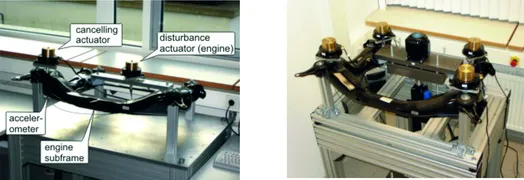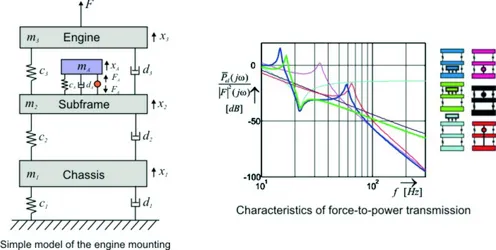Engine Vibration Cancellation
Aim: Isolation of engine-induced vibration.
Approach: Cancelling the vibration close to its source, at the engine mounting.
Specialty: Periodic excitation with basic frequency and harmonics.
Experimental Setups
For the analysis of vibration propagation and cancelling algorithms, experimental setups were installed, which resemble the engine mounting system of an Audi A6.

Subjects of Research
-
Control algorithms for vibration isolation
Implementation of active vibration control systems is possible either in feedback or in feedforward structure. Especially feedforward structures were found to give excellent results for the vibration damping over the complete frequency range of interest. The probably most commonly used algorithm of this kind is the Filtered-x LMS algorithm, but also other types, like adaptive recursive filters or adaptive notch filters are of interest. Feedback algorithms can be implemented in various types as well, e.g. in a classical way or by using Hinf methods.

- Modelling and analysis of power demands
An advantageous configuration of the physical setup of an active vibration control system is crucial for the efficiency of the gained damping. Basis for the therefore necessary fundamental knowledge is a proper modelling of the overall physical system. The results of the modelling make an estimation of power demands possible and are also necessary for controller designs, especially for non adaptive algorithms.

Some Publications / Reports
Comparison of different actuator configurations for active isolation of car engine induced vibration regarding power consumption
Application of Feedforward Structures for Isolation of Car Engine Vibration
Modeling and Aspects of Applicability of Reaction Mass Actuators